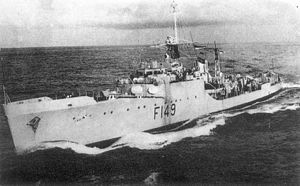INS Khukri (F149)
 INS Khukri underway
| |
| History | |
|---|---|
| Name | INS Khukri[1] |
| Namesake | Khukri |
| Builder | J. Samuel White, Cowes |
| Laid down | 29 December 1955 |
| Launched | 20 November 1956 |
| Commissioned | 16 July 1958 |
| Identification | Pennant number: F149 |
| Fate | Torpedoed and sunk by Pakistan Navy submarine PNS Hangor on 9 December 1971 |
| General characteristics | |
| Class and type | Blackwood-class frigate[2] |
| Displacement | 1,180 long tons (1,199 t) full load[2] |
| Length | 300 ft (91 m)pp 310 ft (94 m)oa[2] |
| Beam | 33 ft (10 m)[2] |
| Draught | 15.5 ft (4.7 m)[2] |
| Propulsion | Y-100 plant; 2 x Babcock & Wilcox boilers, steam turbines on 1 shaft, 15,000 shp (11 MW) |
| Speed | 27.8 knots (51 km/h) maximum, 24.5 knots (45 km/h) sustained[2] |
| Range | 5,200 nautical miles (9,630 km) at 12 knots (22 km/h) |
| Complement | 150[2] |
| Sensors and processing systems |
|
| Armament |
|
INS Khukri was a
| Sinking of INS Khukri | |
|---|---|
| Part of the Arabian sea | |
| Result | INS Khukhri sank[2] |
INS Kirpan (frigate)
194[4]
Sinking
After the beginning of hostilities on 3 December 1971, Indian Naval radio detection equipment identified a submarine lurking about 35 miles (56 km) southwest of Diu harbour. The 14th Frigate Squadron of the Western Fleet was dispatched to destroy the submarine.[2] It normally consisted of five ships, Khukri, Kirpan, Kalveti, Krishna and Kuthar, but at the time of the incident Kuthar's boiler room was being repaired in Bombay.[2] One reason that may have prompted the decision to deploy two obsolete Blackwood-class frigates against a modern Daphne-class submarine was that the Indian Navy lacked sufficient numbers of anti-submarine aircraft.[5]
The submarine sighted the squadron on the evening of 9 December. Khukri was still not aware of the submarine's presence
After a few minutes, Kirpan attacked Hangor with depth charges, as her anti-submarine mortars were no longer functional.[2] Hangor then fired a final torpedo at Kirpan before leaving the area.[2][6] Hangor patrolled the region for the next four days before returning safely to her berth.
Casualties
Khukri is the only ship lost in combat in the history of the Indian Navy.[2][3][9] Eighteen officers and 176 other sailors were killed.[3][9] The captain, Mahendra Nath Mulla, was among the casualties and is the only Indian captain to go down with a vessel as INS Khukri is the only warship of Indian navy lost in combat. He was posthumously awarded India's second-highest military honour, the Maha Vir Chakra.[3][9]
There is a memorial to the sailors in Diu. The memorial consists of a scale model of Khukri encased in a glass house, placed atop a hillock facing the sea. The memorial was inaugurated by Vice Admiral Madhvendra Singh as the flag officer commanding-in-chief.[4]



Controversy
Responsibility for errors by Indian naval officers related to the sinking has caused some controversy. The naval officer who led the inquiry into the sinking, Benoy Bhushan, has claimed that India's official naval history invented fictional accounts to cover up bungling and a surviving sailor from the frigate, Chanchal Singh Gill, has called for an investigation and withdrawal of gallantry awards to negligent officers in the squadron.[10]
See also
- Indo-Pakistani War of 1971
- Timeline of the Bangladesh Liberation War
- Military plans of the Bangladesh Liberation War
- Mitro Bahini order of battle
- Pakistan Army order of battle, December 1971
- Evolution of Pakistan Eastern Command plan
- 1971 Bangladesh genocide
- Operation Searchlight
- Indo-Pakistani wars and conflicts
- Military history of India
- List of military disasters
- List of wars involving India
Notes
- ^ Blackman, Raymond VB (ed.). Jane's Fighting Ships, 1961-62. Sampson Low, Marston & Co Ltd. p. 114.
- ^ a b c d e f g h i j k l m n o p q r s t u v "The Sinking of INS Khukri". Society of Twentieth Century Wargamers Journal. russellphillipsbooks. Archived from the original on 26 March 2012. Retrieved 20 October 2011.
- ^ a b Two-day ceremony at Navy’s Diu memorial Archived 25 April 2013 at the Wayback Machine
- ^ Indian-Subcontinent Database Archived 10 July 2006 at the Wayback Machine
- ^ a b c d Harry, B. "Loss of the INS Khukri". Archived from the original on 18 January 2012. Retrieved 21 October 2011.
- ^ a b Interview with Vice Admiral Tasneem, December 2008
- ^ Friedman, Norman (1984). Submarine design and development. Conway Maritime, p. 188
- ^ a b c Wattal, Ameeta Mulla (9 December 2010). "Why they chose to go down with the ship?". OjNewsCom. Retrieved 7 June 2015.
- ^ Sura, Ajay (7 January 2011). "Khukri sinking: Probe officer terms row 'silly fiction'". Times of India. Retrieved 7 June 2015.
References
- Mankekar, D.R. (1972). Twenty-Two Fateful Days: Pakistan Cut to Size. New Delhi: Indian Book Co.
- Roy, Mihir K. (1995). War in the Indian Ocean. Lancer International.
- "Indian Navy - Blackwood Class Type 14 Frigates". Marine News Supplement: Warships. 76 (5): S277–S281. May 2022. ISSN 0966-6958.

